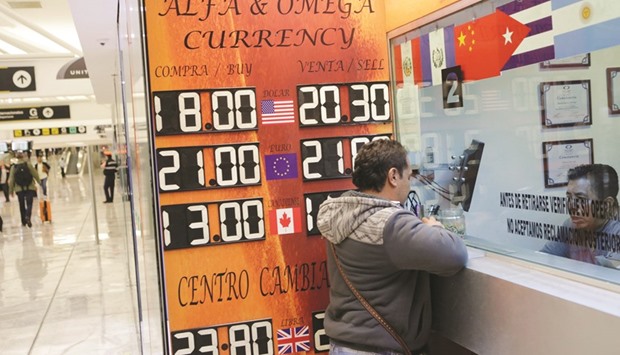The peso tumbled to a record as Donald Trump’s victory in US presidential elections raised the prospect that two decades of Mexican economic integration with its northern neighbour will unravel.
The currency sank 7.7% to 19.7367 per dollar in New York, after earlier dropping as much as 12% as Trump racked up victories in key states to put himself in position to defeat Democratic candidate Hillary Clinton.
The peso acted as a barometer to the presidential campaign, weakening whenever polls swung in favour of Trump, who has pledged to renegotiate the North American Free Trade Agreement and curb illegal immigration by building a wall along the US’s southern border. Analysts at Nomura Holdings and Capital Economics say the currency may fall to as low as 25 per dollar in the aftermath of Trump’s victory.
“The peso is the number one target and it’s in the eye of the storm, not just because of trade,” said Phoenix Kalen, a strategist in London at Societe Generale, which sees the currency depreciating to 23 per dollar. “There are also questions around deportation ofmns of Hispanic immigrants from the US, the repatriation of tax receipts. All of those channels affect the Mexican peso.”
Mexican exports to the US, its biggest trading partner, were more than 10 times the amount for fellow NAFTA member Canada in 2015, according to data compiled by Bloomberg. As well as his hostility to the trade agreement implemented in 1994, Trump has also proposed making Mexico pay to build a wall along the border by blocking immigrant remittances.
The country’s sovereign risk surged yesterday. The extra yield investors demand to buy Mexico’s euro bonds due in 2031 instead of government benchmarks spiked 0.5 percentage point higher to 2.52 percentage points. The cost of insuring Mexican debt against default for five years rose 0.19 percentage point, the most in three years, to 1.64 percentage points
Investors had become more confident about Clinton’s prospects in recent days, with the peso posting a four-day rally that was the biggest since 2009. Those expectations were upended as the vote tallies began to come in.
“Polls were pointing to a relatively solid Democratic win,” said Andres Jaime, a foreign-exchange strategist in New York at Barclays who predicts the peso will fall to 22 per dollar by year-end. Forward points, a measure of the spread between the spot and the forward prices for the Mexican peso, jumped to the highest since 2009. Higher forward points imply traders expect either a weaker peso or faster rate rises in Mexico than in the US The 12-month implied yield rose 0.29 percentage point to 5.49%, the highest since 2010.
Natixis, the most accurate forecaster for the peso in the third quarter, says the currency could end the year at 21 per dollar with a Trump win, while Citigroup sees it weakening to as low as 22 per dollar. Mexico’s sovereign dollar- denominated bond maturing in January 2026 declined, with the yield rising 26 basis points to 3.52%, the highest since June.
Mexico would consider using auctions of interest-rate swaps known as TIIEs if volatility spikes in financial markets, two people with knowledge of the matter said Tuesday. The sales would be similar to what the Latin American nation employed during the 2008 financial crisis, the people said. One person said Mexico would also consider temporary changes to pension fund rules to permit funds more flexibility in case of market volatility.
The steep selloff and the possibility of central-bank intervention has created an opportunity for some investors. Lutz Roehmeyer bought the peso on Wednesday for the $12bn in assets he helps oversee at Landesbank Berlin Investment. He is also buying the rand and the Argentine peso and may buy Brazilian reais, he said.
Central Bank Governor Agustin Carstens said last week that Mexico risks turbulence regardless of the vote outcome and the bank was working on a contingency plan with Finance Minister Jose Antonio Meade. In a separate interview, Meade said there’s little point in intervening in the peso market for now, as selling dollars from the country’s reserves would be like “throwing drops of water into the ocean.”
Mexico hasn’t sold dollars in a discretionary manner to intervene in the foreign-exchange market since February. The central bank may increase rates by more than 100 basis points in the next two days, Commerzbank analysts said in a note.
The peso is undervalued by historical measures. The real effective exchange rate, its trade-weighted value versus a basket of other major currencies, adjusted for inflation, is about 9.6% below the five-year average, according to a Barclays index.

A board displaying the exchange rates of Mexican peso against the US dollar and the euro is seen at a foreign exchange house at the international airport in Mexico City. The peso tumbled to a record as Donald Trump’s victory in US presidential elections raised the prospect that two decades of Mexican economic integration with its northern neighbour will unravel.
